
Europe and Mediterranean: Buyer's Choice Spring in the Aegean Voyage
Regent Seven Seas Cruises
Steeped in Greek mythological history, Mykonos was named after Apollo's grandson, Mykons, and was the location of the grand battle between Zeus and the Gigantes. Today, this island is one of Greece's most adored destinations due to its picture- postcard setting and growing nightlife. Mykonos is a superb example of Cycladic architecture, and by law even new buildings have to be built in the same style of whitewashed, organic, cube-like buildings. Be sure to plan a day trip to take in picturesque Little Venice, the unique Paraportiani church, and the archeological dig at Delos.

Exclusive Costco member savings
$200 Shipboard credit per suite††
All onboard gratuities
Select complimentary shore excursions**
Unlimited beverages, including fine wines and premium spirits served throughout the ship
In-suite refrigerator replenished daily with soft drinks, beer and bottled water
24-Hour room service
No charge for specialty restaurants
Welcome bottle of Champagne
$100 Shipboard credit per suite††
Executive Member Benefit
Executive Members receive an annual 2% Reward, up to $1,250, on qualified Costco Travel purchases
Executive Members receive an additional $100 shipboard credit per suite (not combinable with certain past-guest discounts)††
Digital Costco Shop Card
Member Exclusive: Digital Costco Shop Card with every Regent Seven Seas Cruises® sailing†
Sailing Itinerary

Note: Cruise itineraries are subject to change. Please verify ports and times directly with the cruise line.
Overview
Istanbul is an international art and cultural center. The International Arts and Cultural Festival is held each year in June and July with famous artists coming from all over the world. These performances are held mostly at the Ataturk Cultural Center. Those who enjoy classical music can hear it at the Cemal Resit Rey Hall. Operas, operettas, ballets, films, concerts, exhibitions, and conferences all contribute to the cultural palette of the city. Istanbul also has a rich program of light entertainment. Nightclubs provide splendid entertainment throughout dinner, ranging from a selection of Turkish songs to belly dancing. Istanbul is a preferred city in terms of international art activities. This is because the art lovers of Istanbul are respectful of the art and the artist. The famous performance artists feel very comfortable in Istanbul concerts. Because the audience is very well aware of "the ritual of watching an artistic performance." The artist knows that he or she will not come across with impudent or disrespectful behaviors. It is the same for international picture galleries, biennials, and visual activities. Neither the spectator nor the critic leaves their "respectful attitude against the artist. " Hence the myths of traditional pop-rock genres, giants of jazz, and contemporary legends of classical Western music are always in Istanbul, on the stage. To sum up; Istanbul is a city that can add compassion next to its giant size in terms of living area and population, and try to assimilate the universal culture while "welcoming" it with utmost hospitality: a "world city" In this case, it deserves to be called "universal culture capital"
Overview
Kavala is the main city of Eastern Macedonia and is an important tobacco-growing area and port in the north of Greece. It is very close to the frontiers of both Turkey and Bulgaria and each of these countries has ruled over the city during the 20th century. Kavala has a long and complex history and includes buildings of Roman, Byzantine, and Ottoman origin. It is very close to the Roman city of Philippi, where Octavian and Mark Anthony finally defeated Brutus and Cassius and to whose citizens St. Paul wrote one of his epistles. Modern Kavala is served by a busy international airport, which is used by tour companies to provide access to the nearby island of Thassos. As in Roman times, it lies on the main road from Europe to Asia Minor and it was a stopping point on the "hippy trail" to India and Nepal in the sixties and seventies. The photograph shows the beautiful harbor of Kavala crowned by a bByzantinefort.
Overview
When a Greek tells you he's from Athens, he always sounds a bit apologetic, or regretful; Greeks from Thessaloniki, on the other hand, sound, if not smug, very pleased to be from Greece's "Second City." Thessaloniki may be second to Athens in political importance and population, but in popular songs, Thessaloniki is celebrated as "the mother of Macedonia," "the most blessed of cities," and "the city whose praises are sung." You, too, may be tempted to sing this city's praises when you take in its wonderful situation along the broad expanse of the Thermaic Gulf. You're never far from the sea here; when you least expect it, you'll catch a glimpse of waves and boats in the distance. Alas, especially in the summer, you'll almost certainly get less pleasant whiffs of the harbor's ripe, polluted odor. If you're very lucky, you'll see Mount Olympus while you're here: Pollution has increasingly obscured even that imposing landmark. Greeks are fond of reminding foreigners that when their ancestors were painting themselves blue, or living in rude huts, Greeks were sitting in the shade of the Parthenon, reading the plays of Sophocles. Similarly, Thessalonians like to remind Athenians that when Athens languished in the long twilight of its occupation by the Romans and Ottomans, Thessaloniki flourished. It's true: Thessaloniki's strategic location on the main land route from Europe into Asia made it a powerful city during the Roman Empire -- you'll see many monuments built here by the 4th-century A.D. emperor Galerius. During the Byzantine Empire (the 4th-15th centuries A.D.), Thessaloniki boasted that it was second only to the capital, Constantinople. That's when Thessaloniki's greatest pride, its superb and endearing churches, were built. After the Turks conquered the Byzantine Empire, Thessaloniki continued to flourish as an important commercial center and port. In the 18th and early 19th centuries, the city's Jewish community was so strong and so prosperous that some called Thessaloniki the "second Jerusalem." Then, in August 1917, a devastating fire destroyed 80% of the city. Phoenix-like, Thessaloniki rose from the ashes. Unfortunately, only part of the city was rebuilt according to the grand plan of the French architect Ernest Hébrard -- in part because of the 130,000 Greek refugees from Asia Minor who flooded into Thessaloniki between 1922 and 1923, almost doubling the city's population and leading to enormous unregulated development. Still, Thessaloniki has the broad tree-lined boulevards and parks that Athens so sadly lacks. After World War II, and again in the 1960s, two more growth spurts left much of the city's outskirts crowded and ugly -- and all too much of the city center lined with bland apartment buildings. You'll notice, however, that Thessaloniki has none of the horizon-blocking skyscrapers that have proliferated in Athens -- earthquake regulations forbid this. The last major earthquake was in 1978. Glimpses of the sea, tree-lined streets, magnificent Byzantine churches -- all these make visiting Thessaloniki delightful. And there's something else here that's quite wonderful: the food. In part, this is because of the long tradition of Macedonian cuisine; in part, because the refugees who came here from Turkey in 1922 brought with them the zesty cuisine of the Pontus (the area around the Black Sea where most of the refugees had lived). In addition, this is still a city whose establishments are supported by local customers. There are no restaurants here -- as yet -- that make their living off tourists. If you're a visitor to Thessaloniki, you'll appreciate all this. You'll also enjoy the fact that Thessaloniki's location in the virtual center of Macedonia makes it the perfect place from which to set off to the sites associated with Philip II of Macedon and his son Alexander the Great. If you are a man, you can also take in the monasteries of Mount Athos, the Holy Mountain. If you are a woman, you'll have that much more time to enjoy Thessaloniki -- or to sit patiently in the little port of Ouranopolis, the jumping-off point for Mount Athos, and envy those lucky enough to travel on to the Holy Mountain. High Season -- The busiest time of the year in Thessaloniki is not summer, but fall, when the International Trade Fair and Festival of Greek Songs take place in September, followed by the Demitria celebrations of the city's patron saints in October and November. There is also a Film Festival here in November. If you come between September and November, be sure to book a hotel in advance -- and be prepared to pay top money for your room (price hikes of 25% are common). Strategies for Seeing Thessaloniki -- Our suggestions on exploring Thessaloniki are just that: suggestions. Unlike Athens, which few visitors would be bold enough to visit without seeing the Acropolis, Thessaloniki has no one "must-see" monument. Some might argue that the splendid Archaeological Museum or the Museum of Byzantine Culture fit the bill, but others would plead the case of the Upper City (Ano Poli), the old Turkish Quarter. Still, others would recommend a loop through both the Upper City and the city center to take in as many Byzantine churches and Roman monuments as possible. In short, you're here to enjoy the city itself: a city filled with Byzantine churches and chapels, a city with squares built around Roman palaces, whose markets pulse with life, and whose harborside cafes and promenades refresh the weary.
Overview
Volos is the capital city of the region of Magnesia. It was built at the foot of the mountain of Pelion and is 325km from Athens, and 216km from Thessalonica. The ancient city "Dimitrias", which is situated a little further out from where Volos is today, was established in the 3rd century BC by the Macedonian king "Dimitrios the Sieger". By the middle of the 6th century AD, it was the centre for shipbuilding. In the town of "Palaia" (Old) the castle of Volos was built. It was here that a market square was created and trading of products began by the people of Pelion and the valley of Thessaly.To protect the market from raiders, a small fortress was built. This was known as the "Kastrin" (Little castle). This fort, through the years, was under the leadership of Byzantine leaders and Ottoman leaders during the Turkish occupation. In 1665 the fortress was attacked, for the last time, by the Venetian navy under the leadership of Morosini. After this attack, they started to build small stores for the products, which were mainly cereals, from the valley of Thessaly. These stores started to spread around the port. Eventually, small houses for the traders started to be built around the east side of the castle.After 1830, a large number of villagers and craftsmen from the villages of Pelion the new state of Greece and other Hellenistic centres started building houses and workshops around the port. This was the beginning of large-scale trading in the area, which was continuously getting bigger and bigger.When Thessaly joined in with the Greek state, a large trading market started, and by the end of the century, there was an explosion in trade and industry. This resulted in the port of Volos becoming the second biggest trade port in Greece after Piraeus. With the port continuously expanding, the rail operation developed to connect Volos with the rest of Greece. This became the fastest and cheapest means of transportation for both products and people and helped Volos become a very rich city. In turn, this increase in wealth also helped with building and development in the area and work started on many neoclassic buildings and churches, such as Agioi Konstantinos, Agios NNikolaosand the church of Metamorphosis. The railway station and many workshops were also constructed during these prosperous times.This development took place at a fast rate and many industries started establishing themselves. Textile, ore and ceramic industries started and led to more wealth and power. The steam train of Pelion "Moutzouris-Smudgy" was built by the Italian engineer Evaristo de Kiriko, and connected the previously unapproachable villages with the port of Volos. Again, this led to an increase in trade and markets.In 1922, after the disaster in Asia Minor, many refugees fled and headed to Volos, where they found new homes and began a new life. They also contributed to trading and developments in the city. A very important landmark in the city's development was the big earthquake in 1955 when almost the whole city was destroyed. The city was rebuilt and is how you see it today. Volos is a very lively city, and its port connects with the North Sporades and has connections with ports all over the world. The rail lines connect it with the rest of Greece and more recently the airport at Anhialos. Today Volos is a big industrial centre and has the third largest port in Greece.Volos consists of the municipalities of Neas Ionias and Iolkos. Volos has a very famous and high-quality open market, which is on level with any other markets throughout cities in Greece.Volos is a very happy and pleasant city. One thing you must do is to visit one of the fish tavernas, "tripouradika", and enjoy fish titbits and tsipouro. Once you have experienced this, you will forever have this picture in your mind and heart.
Overview
Today Piraeus is the home base of Greek shipping, the largest commercial fleet in the world, apace bound to the sea like few others. The harbors of Zea and Mikrolimano as well as Phaliro play host to countless yachts and sailing craft throughout the year. Piraeus was known in medieval times as Porto Leone, a name due to the enormous stone lion, which guarded the port's entrance. Today, the life of Piraeus is centered on its three ports: the main, central one, and those of Zea and Mikrolimano. You can walk around the central harbor, shared by cargo and passenger ships alike, and watch the constant comings and goings of goods and people from around the world. Having completed your tour of the central harbor of Piraeus you will then head south traversing the peninsula and arriving at Peiraiki, one of the most picturesque neighborhoods in the city. Here one finds the harbor of Zea, one of the largest marinas in the Mediterranean. If the night finds you in the area, you can try one of the many bars found nearby. You can continue your tour along the waterfront heading towards Kastella but a small deviation toward the city center will be useful for then you can visit the verdant square of the municipal Theatre with cafeterias and shops of all kinds surrounding it. The magnificent building housing the Municipal Theatre as well as the Town Hall and the Library complete the picture presented by the main square in the city. Piraeus's little natural harbors are among its busiest and most touristy areas: Mikrolimano, Passalimani, Zea, Freatida, and Hatzikiriakio. Countless seaside tavernas provide delicious seafood washed down with the uniquely Greek drink, ouzo. The fresh smell of the sea and the sounds made by the assortment of caiques, yachts, and sailing ships, which are moored next to the tables, complete the enjoyment of the food Beyond the port, the most impressive spots are the hills of Profitis Ilias and Kastela with their neoclassical mansions and modern buildings which look as they are hanging over the sea.
Overview
Mykonos is world-famous. It is no coincidence that this, the most cosmopolitan of all Greek islands, attracts so many visitors from all over the globe, including large numbers of artists and intellectuals. Here, the steep mountains to be encountered in most of the Cyclades give way to low, rocky hills which combine with superb beaches to make up the landscape of the island. The capital, Hora (Chora), with its colourful harbour in which little fishingboats nestle happily side by side with luxury yachts, presents quite a different picture from the majority of Aegean island towns. While it is usual for island villages to be built on naturally amphitheatrical sites, Mykonos is spread out over a flat area and conveys an impression of lid aesthetic cohesion. Along the whitewashed streets stand brilliant white box-shaped houses with stepped walls for sitting on, wooden doors and windows and brightly-coloured balconies. These are interspersed with small but impressive churches, pretty little tavernas and shops selling souvenirs and other goods, and the overall sense is of being inside a film set. On the low Kastro hill is the complex of churches known collectively as Our Lady 'Paraportiani', a superb arrangement of whitewashed masses created over the centuries and now recognised as a national cultural monument. Of particular historical and aesthetic interest are the medieval houses in this district of the town, which stand like a wall above the sea protecting the west side of Hora. The Archaeological Museum of Hora contains finds from tombs on the nearby island of Rhenia, sculptures, vases and figurines. The Folklore Museum brings together a number of collections of furniture, icons, pieces of sculpture and folk musical instruments. Mykonos is also the home of the Nautical Museum of the Aegean, which has interest all of its own. The countryside of Mykonos is a mixture of grey-green rocks ringed by prickly pear plants and little fertile areas carpeted with wild flowers. Here and there are tiny whitewashed chapels and windmills. Ano Mera is, after Hora, the most important of the older villages on the island. Standing 8 km. to the east of the town, Ano Mera has the interesting monastery of Our Lady Tourliani, ornamented with fine wood-carvings. The church has a collection of valuable ecclesiastical vessels, vestments and embroideries. The courtyard contains an interesting bell-tower and a marble fountain. Here lovers of the sea will find outstanding golden beaches such as Agios Stefanos, Psarou, Kalafatis, Platis Gialos, Ornos, Elia and Panormos. Miykonos is a busy island with all the amenities of a modern resort and with plenty to do - by day or night for those who want to have a lively time. Yet visitors fond of more peaceful holidays will still find quiet corners in which to relax.
Overview
Iraklion is the capital of Crete and of the prefecture of Iraklion. It is easily accessible from Athens by at least four flights a day. There are international flights from Iraklion to Frankfurt and Amsterdam. Between April and October, there are charters from many other European cities. Iraklion is a very busy city, especially during the tourist season, so it is advisable to book reservations for accommodation before arrival, especially during August. If you are traveling by car there are parking lots near the end of Kalokairinou Street at the Chanioporta and below the Archaeological Museum, one of the many uses of a medieval moat. Make use of them and take the opportunity to see the historical monuments. As you walk up 25 August (Odos 25 Avgoustou) Street you will see numerous agencies advertising tours of all kinds. Santorini, Rhodes, and Mikonos are some of the most visited islands. You can also arrange tours of Knossos, Festos, Gortyn, and the Samaria Gorge. Most of the offices are professional and offer good value. However, to avoid confusion and disappointment, pay attention to the details of the trip, such as the time of pick up, time of arrival at the site, time spent at the site, and entrance fees; these may sometimes be vague. The National Road is easily reached from Iraklion. You can drive to Agios Nikolaos in 1 hr (72km) and Chania in 2 hours (137km). This road is enjoyable and the scenery is spectacular. Drive with caution on all roads in Crete. All means of transportation, including donkeys, farm equipment, and tour buses use the roads at varying speeds. These facts are not truly understood by many of the tourists or even the locals. Iraklion is the fifth largest city in Greece and there has been a settlement here since Neolithic times. Although few remains have been found in the city proper, it was probably a port for Knossos during Minoan and Roman times. The Saracens captured it in 824 A.D. and renamed it El Khandak (The Moat) after the moat they dug around it. The city was regained by the Byzantine Empire in 961 A.D. after many unsuccessful attempts. After the Crusaders occupied Constantinople in 1204, they gave Crete to Boniface of Monferrat who sold the island to Venice for one thousand pieces of silver. Under Venetian rule, the arts flourished, and “Candia”, as the Venetians renamed it, became a center of learning. Many scholars and artists took refuge in Candia after the fall of Constantinople in 1453. The Venetians began construction of the city walls in 1462, which were completed more than a century later. The walls were 4km in length, of a triangular shape, and had seven bastions. The Venetians also built the harbor and various other masterly architectural works. The walls proved their deterrent strength when the city was besieged for 21 years, one of the longest sieges in history. The final surrender came in 1669 after 100,000 Turks and 30,000 Venetians had been killed. Turkish occupation was heavily resented by the Cretans and continuous guerrilla warfare was waged against the Turks and, in return, the Turks often made reprisals against the Cretan population in the cities. Iraklion grew in size after the 1913 union with Greece. However, its strategic location again made it a target for invading forces in 1941. The German bombardment during the Battle of Crete caused a great amount of damage and after the war, the city was extensively rebuilt. Chania was originally the capital of Crete. The administrative center of Crete was transferred to Iraklion in 1971.
Overview
The cosmopolitan charms of Marmaris, which used to be a fishing village less than 20 years ago, will surprise anyone with a choice of accommodation and entertainment. Marmaris is a Turkish Rivera. Once you set your foot here you will join its true vacation atmosphere! The old quarter of the town with its bustling bazaars and restaurants is well worth a visit. During the day, people head for the beach to do catamaran trips, parasailing, water skiing, sailing, scuba diving, and the list goes on! Yet in Marmaris, you are not confined to the town beach. Icmeler and its beach is 8 km down the road. Alternatively, take advantage of one of the boats that chug away in the morning from the marina to scores of sandy beaches like Cleopatra's Island and Turtle Beach.Once a little fishing port, Marmaris has developed into one of Turkey's busiest and most Anglicized resorts. Its port welcomes luxury cruise liners, which disgorge passengers keen to sample the town's extensive facilities and visit the archaeological sites nearby, just to name a few - the ancient city of Efes, (the second biggest city of the Roman Empire, after Rome); another sightseeing place not to be missed is Pamukkale, that is considered to be the 8th world wonder. And much more! Marmaris also is South Aegean's prettiest resort for scuba diving. Several dive centers in Marmaris arrange guided diving trips, and excursions and even provide diving lessons for inexperienced individuals, eager to try out this underwater sport. Shopping is a delight in Marmaris. Some truly shop till they drop into this shopping Mecca! Leather goods of all kinds, natural sponges, and the local blue glass beads (the Boncuk) are among the bargains to be found in the friendly little shops along the downtown bazaar. Charming boutiques at the end of the promenade offer kilims, carpets, and embroidery as well as original fashions.
Overview
Walking around this charming city, one can see a lot, ranging from the oldest remains, to the most recent establishments scattered around. The clocktower stands in Konak Square as a symbol of the city while nearby the Archaeological Museum houses many finds from the early western Anatolian civilizations. In the city center, there is the Kultur Park (Culture Park) where the famous annual International Fair is held. Filled with pretty restaurants, cafes, shops, and bars, Kordonboyu is a long promenade, that provides a restful atmosphere and the typical elegant scenery of the city. Kemeralti Bazaar is a smart place with limitless shopping opportunities for here you will find almost anything you want, at the most appropriate prices.
Overview
Istanbul is an international art and cultural center. The International Arts and Cultural Festival is held each year in June and July with famous artists coming from all over the world. These performances are held mostly at the Ataturk Cultural Center. Those who enjoy classical music can hear it at the Cemal Resit Rey Hall. Operas, operettas, ballets, films, concerts, exhibitions, and conferences all contribute to the cultural palette of the city. Istanbul also has a rich program of light entertainment. Nightclubs provide splendid entertainment throughout dinner, ranging from a selection of Turkish songs to belly dancing. Istanbul is a preferred city in terms of international art activities. This is because the art lovers of Istanbul are respectful of the art and the artist. The famous performance artists feel very comfortable in Istanbul concerts. Because the audience is very well aware of "the ritual of watching an artistic performance." The artist knows that he or she will not come across with impudent or disrespectful behaviors. It is the same for international picture galleries, biennials, and visual activities. Neither the spectator nor the critic leaves their "respectful attitude against the artist. " Hence the myths of traditional pop-rock genres, giants of jazz, and contemporary legends of classical Western music are always in Istanbul, on the stage. To sum up; Istanbul is a city that can add compassion next to its giant size in terms of living area and population, and try to assimilate the universal culture while "welcoming" it with utmost hospitality: a "world city" In this case, it deserves to be called "universal culture capital"
Overview
Istanbul is an international art and cultural center. The International Arts and Cultural Festival is held each year in June and July with famous artists coming from all over the world. These performances are held mostly at the Ataturk Cultural Center. Those who enjoy classical music can hear it at the Cemal Resit Rey Hall. Operas, operettas, ballets, films, concerts, exhibitions, and conferences all contribute to the cultural palette of the city. Istanbul also has a rich program of light entertainment. Nightclubs provide splendid entertainment throughout dinner, ranging from a selection of Turkish songs to belly dancing. Istanbul is a preferred city in terms of international art activities. This is because the art lovers of Istanbul are respectful of the art and the artist. The famous performance artists feel very comfortable in Istanbul concerts. Because the audience is very well aware of "the ritual of watching an artistic performance." The artist knows that he or she will not come across with impudent or disrespectful behaviors. It is the same for international picture galleries, biennials, and visual activities. Neither the spectator nor the critic leaves their "respectful attitude against the artist. " Hence the myths of traditional pop-rock genres, giants of jazz, and contemporary legends of classical Western music are always in Istanbul, on the stage. To sum up; Istanbul is a city that can add compassion next to its giant size in terms of living area and population, and try to assimilate the universal culture while "welcoming" it with utmost hospitality: a "world city" In this case, it deserves to be called "universal culture capital"
Onboard the Seven Seas Splendor
Seven Seas Splendor
Year Built: 2020
Double Occupancy Capacity: 750
From her grand social spaces to the private balconies adorning every suite, Seven Seas Splendor is a work of art from bow to stern. The detail attended to and the artistry displayed in every corner echoes the excellence achieved aboard Seven Seas Splendor. With itineraries across the globe, you can explore some of the world's most fascinating destinations in luxurious comfort.
Activities & Services (included in cruise)
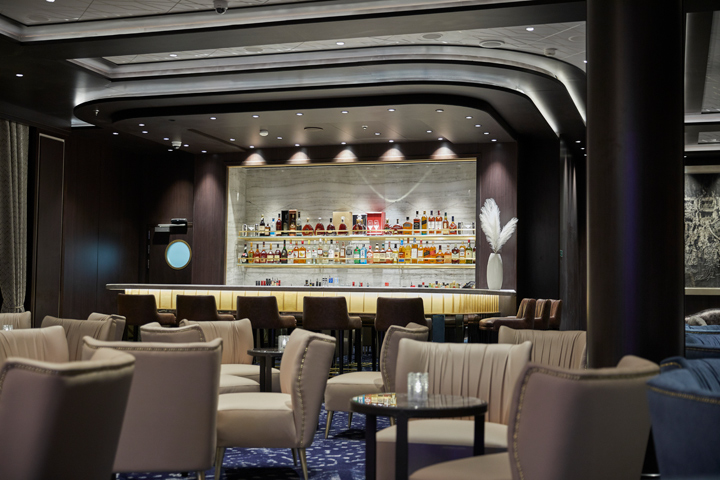
Lounge
- Card Room
- Casino
- Theater/Show Lounge
- Fitness Center
- Pool - Outdoor
- Library
- Wi-Fi
- Business Center
- Concierge Desk
- Dry Cleaning/ Laundry Service
- Elevators
- Safe Deposit Boxes
Activities & Services (available for an extra fee)
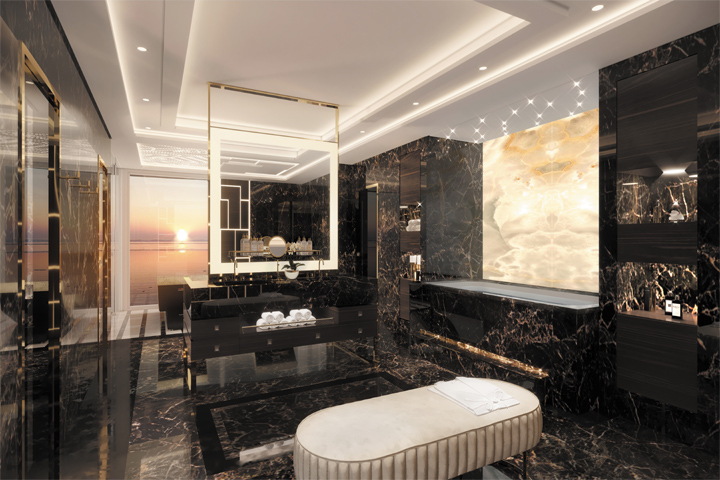
Full-Service Spa
- Full-Service Spa
- Spa Services/Massage
- Duty-Free Shops/Boutiques
- Infirmary/Medical Center
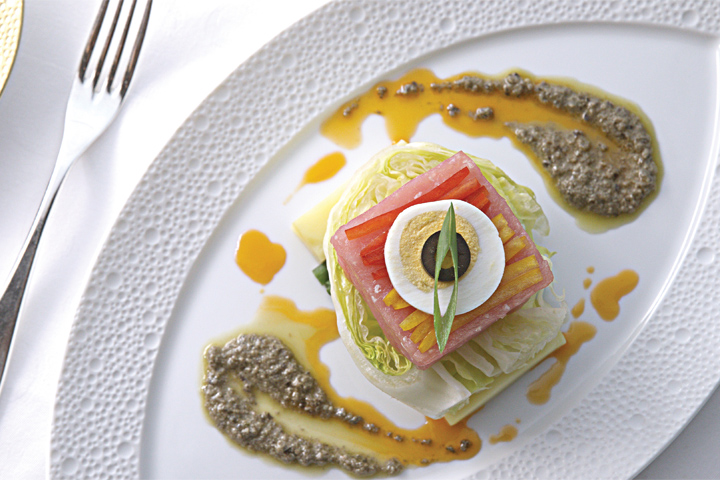
Chartreuse
Specialty Dining
Chartreuse: Featuring a classic French menu with a modern twist, Chartreuse evokes memories of a chic Parisian fine dining restaurant discovered during an evening stroll. Wherever you are seated in this regal restaurant, you will be treated to a succulent dinner while enjoying incredible ocean views. The restaurant ambiance is complemented by a menu that features dishes expertly prepared using both classic and modern techniques for a multiple course celebration of French gastronomy.
Compass Rose: Much thought was given to the design of Compass Rose, the flagship restaurant of Regent Seven Seas fleet. The dining room is outfitted with rich woods contrasted by light marble stones and mother of pearl shimmering brightly with an elegant color theme of light shades of blue, white, gold and silver. Compass Rose delights with a beautifully defined atmosphere and transitions from refreshing natural light during the day to a romantic ice blue lighting theme at night. This is the perfect setting for you to enjoy your breakfast, lunch and dinner, where the menu features an exceptional variety of Continental cuisine.
Pacific Rim: Celebrating the culinary traditions of Asia, Pacific Rim delights guests with the perfect balance of delicious flavors and Zen-like ambiance. The restaurant is located on Deck 5, and the interior glows with muted lighting that illuminates intricate architectural details. During dinner, guests are treated to incredible ocean views through windows designed in an abstract lotus shape, a universal Asian motif. To complement the stunning décor, Pacific Rim's chefs created a delectable menu of Pan-Asian creations with dishes such as grilled Korean barbecue lamb chops, wok-fried beans, eryngii mushroom and gochujang dressing. Pacific Rim is open for dinner each evening, reservations are required.
Prime 7: A true classic in every sense, Prime 7 sets a new standard in steakhouse fare with its contemporary interpretation of an American favorite. Handsomely decorated with supple leather wing-back chairs, burnished woods and rich earth-toned fabrics, Prime 7 exudes a distinct, intimate elegance. All the traditional starters are here, including Jumbo Lump Crab Cakes, Classic Steak Tartare, and Clam Chowder. Of course, beef is the undisputed star, and it is all USDA Prime and Dry-Aged at least 28 days to ensure the ultimate tenderness, juiciness and flavor. Prime New York Strip, Porterhouse Steak and succulent Filet Mignon only touch upon the selections. Mouthwatering alternatives include Alaskan King Crab Legs and Dover Sole. Prime 7 is open for dinner only and reservations are required.
Sette Mari at La Veranda: Each evening, La Veranda transforms into Sette Mari at La Veranda, a casual, intimate dining experience. Enjoy an extensive menu of authentic antipasti and Italian specialties served á la carte and paired with fine Italian wines — complimentary of course. Delectable dishes are prepared á la minute by talented chefs using only the freshest gourmet ingredients and served by attentive waiters. Sette Mari at La Veranda is open for dinner only.
Casual Dining
La Veranda Restaurant: Take in stunning ocean views while enjoying elegant breakfast and lunch buffets in the chic indoor dining room or al fresco on the shaded, open-air deck. Breakfasts include traditional favorites, as well as a made-to-order omelet station, a variety of fresh fruits and pastries, along with daily specials, like fluffy Belgian waffles with fresh blueberry compote. For lunch indulge in an array of choices from a bountiful salad bar, gourmet sandwiches, hot carving stations and delicious desserts.
Pool Grill: The Pool Grill is open-air, yet abundantly shaded for comfortable dining. Enjoy grilled-to-order burgers, grilled seafood, sandwiches, and fresh salads. Treat yourself to milkshakes and malts or an old-fashioned hand-dipped ice cream dessert sprinkled with all your favorite toppings.
Room Service: Complimentary 24-hour dining in the comfort of your stateroom.
Features a European king-size bed, a sitting area, a marble bathroom, a walk-in closet and a balcony. Concierge Level is available.

Category: H
A wonderfully cozy retreat that includes a private balcony. In addition to a signature European Queen Size Elite Slumber™ bed, you'll enjoy amenities such as lavish bath products, an interactive flat-screen television and a plush bathrobe and slippers. The intimate sitting area includes a table that is the perfect size for breakfast for two or a couple of glasses and a bottle of celebratory Champagne.
Suite size: 20.4 m²
Balcony size: 8.2 m²
Amenities:- Unlimited Wi-Fi Includes Two Logins, Two Devices, per Suite
- Valet Laundry Service
- Customizable In-Suite Mini Bar Replenished Daily with Your Preferences
- Welcome Bottle of Champagne and Fresh Fruit
- 24-hour In-Suite Dining
- Fresh Orchid Arrangement
- L'Occitane® Jasmin & Bergamot Bath Amenities
- Regent Plush Bathrobe and Slippers
- Interactive Flat-Screen Television and Direct-Dial Satellite Phone
- Vanity and Hair Dryer
- Shoe Shine Service

Category: G1
Every inch of this suite has been thoughtfully designed to maximize interior space and embrace the magnificent scenery outdoors. From the sitting area, admire the ocean views through the floor-to-ceiling windows, or better yet, take a seat outside on your private balcony to watch the world go by. Elegant finishes such as luxurious bedding and beautiful marble detailing in the bath further enhance your comfort.
Suite size: 23.5 m²
Balcony size: 8.2 m²
Amenities:- Unlimited Wi-Fi Includes Two Logins, Two Devices, per Suite
- Valet Laundry Service
- Customizable In-Suite Mini Bar Replenished Daily with Your Preferences
- Welcome Bottle of Champagne and Fresh Fruit
- 24-hour In-Suite Dining
- Fresh Orchid Arrangement
- L'Occitane® Jasmin & Bergamot Bath Amenities
- Regent Plush Bathrobe and Slippers
- Interactive Flat-Screen Television and Direct-Dial Satellite Phone
- Vanity and Hair Dryer
- Shoe Shine Service

Category: G2
Every inch of this suite has been thoughtfully designed to maximize interior space and embrace the magnificent scenery outdoors. From the sitting area, admire the ocean views through the floor-to-ceiling windows, or better yet, take a seat outside on your private balcony to watch the world go by. Elegant finishes such as luxurious bedding and beautiful marble detailing in the bath further enhance your comfort.
Suite size: 23.5 m²
Balcony size: 5.1-10.0 m²
Amenities:- Unlimited Wi-Fi Includes Two Logins, Two Devices, per Suite
- Valet Laundry Service
- Customizable In-Suite Mini Bar Replenished Daily with Your Preferences
- Welcome Bottle of Champagne and Fresh Fruit
- 24-hour In-Suite Dining
- Fresh Orchid Arrangement
- L'Occitane® Jasmin & Bergamot Bath Amenities
- Regent Plush Bathrobe and Slippers
- Interactive Flat-Screen Television and Direct-Dial Satellite Phone
- Vanity and Hair Dryer
- Shoe Shine Service
Spacious suites feature an in-suite iPad, daily canapés and upgraded bathroom amenities.
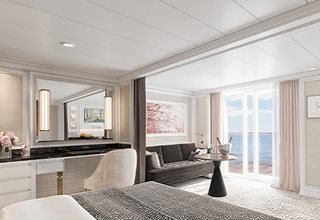
Category: F2
With more than 400 square feet of space including a private balcony, this suite is an excellent choice if you want a little extra room. Even your sleeping accommodations are spacious, as the Elite Slumber™ bed is a European king-size and faces floor-to-ceiling windows that provide ocean views from your bed. A walk-in closet, dual sinks in the bathroom and wonderful bath amenities make it a pleasure to prepare for your day's adventures.
Suite size: 30.8 m²
Balcony size: 7.7-10.7 m²
Amenities:- Unlimited Wi-Fi Includes Two Logins, Two Devices, per Suite
- Valet Laundry Service
- Customizable In-Suite Mini Bar Replenished Daily with Your Preferences
- Welcome Bottle of Champagne and Fresh Fruit
- 24-hour In-Suite Dining
- Fresh Orchid Arrangement
- L'Occitane® Jasmin & Bergamot Bath Amenities
- Regent Plush Bathrobe and Slippers
- Interactive Flat-Screen Television and Direct-Dial Satellite Phone
- Vanity and Hair Dryer
- Shoe Shine Service

Category: F1
With more than 400 square feet of space including a private balcony, this suite is an excellent choice if you want a little extra room. Even your sleeping accommodations are spacious, as the Elite Slumber™ bed is a European king-size and faces floor-to-ceiling windows that provide ocean views from your bed. A walk-in closet, dual sinks in the bathroom and wonderful bath amenities make it a pleasure to prepare for your day's adventures.
Suite size: 30.8 m²
Balcony size: 7.7-12.3 m²
Amenities:- Unlimited Wi-Fi Includes Two Logins, Two Devices, per Suite
- Valet Laundry Service
- Customizable In-Suite Mini Bar Replenished Daily with Your Preferences
- Welcome Bottle of Champagne and Fresh Fruit
- 24-hour In-Suite Dining
- Fresh Orchid Arrangement
- L'Occitane® Jasmin & Bergamot Bath Amenities
- Regent Plush Bathrobe and Slippers
- Interactive Flat-Screen Television and Direct-Dial Satellite Phone
- Vanity and Hair Dryer
- Shoe Shine Service

Category: E
In this superbly designed suite, enjoy once-in-a-lifetime views of the horizon from the comfort of your King-Sized Elite Slumber™ Bed as well as exclusive luxuries available only in suites at the Concierge level and higher. Your suite includes amenities such as an illy® espresso maker and cashmere blankets, perfect for use in the morning when you wish to sip coffee and enjoy an in-suite breakfast on your private balcony.
Suite size: 30.8 m²
Balcony size: 10.7-12.3 m²
Amenities:- 1-Night Pre-Cruise Hotel Package Including:
- Ground Transfers
- Breakfast
- Porterage
- Unlimited Wi-Fi Includes up to Four Logins, Four Devices, per Suite
- Valet Laundry Service
- Customizable In-Suite Mini Bar Replenished Daily with Your Preferences
- Welcome Bottle of Champagne and Fresh Fruit
- 24-hour In-Suite Dining
- Fresh Orchid Arrangement
- L'Occitane® Jasmin & Bergamot Bath Amenities
- Regent Plush Bathrobe and Slippers
- Interactive Flat-Screen Television and Direct-Dial Satellite Phone
- Priority Access to Online Shore Excursion Reservations
- Priority Access to Online Dining Reservations
- Binoculars
- illy® Espresso Maker
- Cashmere Blankets
- Regent Special Gift
- Vanity and Hair Dryer
- Shoe Shine Service
- Additional Discounts:
- 10% Discount on Ultra Premium Wine and Liquor
- 5% Savings on Pre- or Post-Cruise Hotel or Land Programs
- 5% Savings on Regent Choice Shore Excursions
- 1-Night Pre-Cruise Hotel Package Including:

Category: D
In this superbly designed suite, enjoy once-in-a-lifetime views of the horizon from the comfort of your King-Sized Elite Slumber™ Bed as well as exclusive luxuries available only in suites at the Concierge level and higher. Your suite includes amenities such as an illy® espresso maker and cashmere blankets, perfect for use in the morning when you wish to sip coffee and enjoy an in-suite breakfast on your private balcony.
Suite size: 30.8 m²
Balcony size: 7.7-12.3 m²
Amenities:- 1-Night Pre-Cruise Hotel Package Including:
- Ground Transfers
- Breakfast
- Porterage
- Unlimited Wi-Fi Includes up to Four Logins, Four Devices, per Suite
- Valet Laundry Service
- Customizable In-Suite Mini Bar Replenished Daily with Your Preferences
- Welcome Bottle of Champagne and Fresh Fruit
- 24-hour In-Suite Dining
- Fresh Orchid Arrangement
- L'Occitane® Jasmin & Bergamot Bath Amenities
- Regent Plush Bathrobe and Slippers
- Interactive Flat-Screen Television and Direct-Dial Satellite Phone
- Priority Access to Online Shore Excursion Reservations
- Priority Access to Online Dining Reservations
- Binoculars
- illy® Espresso Maker
- Cashmere Blankets
- Regent Special Gift
- Vanity and Hair Dryer
- Shoe Shine Service
- Additional Discounts:
- 10% Discount on Ultra Premium Wine and Liquor
- 5% Savings on Pre- or Post-Cruise Hotel or Land Programs
- 5% Savings on Regent Choice Shore Excursions
- 1-Night Pre-Cruise Hotel Package Including:
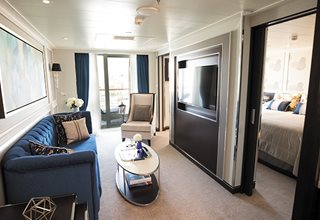
Category: C
Your personal haven at the end of each day, this luxurious suite has been carefully designed to maximize space and comfort. Relax on your private balcony and indulge in your lavish bath amenities as you recharge and ready yourself for a new adventure in the next port of call. This suite also features a spacious walk-through closet and separated living and bedroom areas that can be closed with pocket doors for privacy.
Suite size: 41.8 m²
Balcony size: 10.3-18.0 m²
Amenities:- 1-Night Pre-Cruise Hotel Package Including:
- Ground Transfers
- Breakfast
- Porterage
- Unlimited Wi-Fi Includes up to Four Logins, Four Devices, per Suite
- Valet Laundry Service
- Customizable In-Suite Mini Bar Replenished Daily with Your Preferences
- Welcome Bottle of Champagne and Fresh Fruit
- 24-hour In-Suite Dining
- Fresh Orchid Arrangement
- L'Occitane® Jasmin & Bergamot Bath Amenities
- Regent Plush Bathrobe and Slippers
- Interactive Flat-Screen Television and Direct-Dial Satellite Phone
- Priority Access to Online Shore Excursion Reservations
- Priority Access to Online Dining Reservations
- Binoculars
- illy® Espresso Maker
- Cashmere Blankets
- Regent Special Gift
- Vanity and Hair Dryer
- Shoe Shine Service
- Additional Discounts:
- 10% Discount on Ultra Premium Wine and Liquor
- 5% Savings on Pre- or Post-Cruise Hotel or Land Programs
- 5% Savings on Regent Choice Shore Excursions
- Personal Butler for an Elevated In-Suite Experience
- In-Suite Dining from Compass Rose
- Daily Canapés
- Luxurious Designer Bath Amenities & Men's Unscented Shaving Kit
- Guerlain Bath Amenities & Men's Unscented Shaving Kit
- Bose® SoundLink Mini II Bluetooth Speaker
- Selection of Bed Pillow Styles
- Complimentary Garment Pressing on First Night
- Personalized Stationery upon request
- 1-Night Pre-Cruise Hotel Package Including:

Category: B
Your personal haven at the end of each day, this luxurious suite has been carefully designed to maximize space and comfort. Relax on your private balcony and indulge in your lavish bath amenities as you recharge and ready yourself for a new adventure in the next port of call. This suite also features a spacious walk-through closet and separated living and bedroom areas that can be closed with pocket doors for privacy.
Suite size: 41.8 m²
Balcony size: 10.3-16.4 m²
Amenities:- 1-Night Pre-Cruise Hotel Package Including:
- Ground Transfers
- Breakfast
- Porterage
- Unlimited Wi-Fi Includes up to Four Logins, Four Devices, per Suite
- Valet Laundry Service
- Customizable In-Suite Mini Bar Replenished Daily with Your Preferences
- Welcome Bottle of Champagne and Fresh Fruit
- 24-hour In-Suite Dining
- Fresh Orchid Arrangement
- L'Occitane® Jasmin & Bergamot Bath Amenities
- Regent Plush Bathrobe and Slippers
- Interactive Flat-Screen Television and Direct-Dial Satellite Phone
- Priority Access to Online Shore Excursion Reservations
- Priority Access to Online Dining Reservations
- Binoculars
- illy® Espresso Maker
- Cashmere Blankets
- Regent Special Gift
- Vanity and Hair Dryer
- Shoe Shine Service
- Additional Discounts:
- 10% Discount on Ultra Premium Wine and Liquor
- 5% Savings on Pre- or Post-Cruise Hotel or Land Programs
- 5% Savings on Regent Choice Shore Excursions
- Personal Butler for an Elevated In-Suite Experience
- In-Suite Dining from Compass Rose
- Daily Canapés
- Luxurious Designer Bath Amenities & Men's Unscented Shaving Kit
- Guerlain Bath Amenities & Men's Unscented Shaving Kit
- Bose® SoundLink Mini II Bluetooth Speaker
- Selection of Bed Pillow Styles
- Complimentary Garment Pressing on First Night
- Personalized Stationery upon request
- 1-Night Pre-Cruise Hotel Package Including:

Category: A
Your personal haven at the end of each day, this luxurious suite has been carefully designed to maximize space and comfort. Relax on your private balcony and indulge in your lavish bath amenities as you recharge and ready yourself for a new adventure in the next port of call. This suite also features a spacious walk-through closet and separated living and bedroom areas that can be closed with pocket doors for privacy.
Suite size: 41.8 m²
Balcony size: 10.3-16.4 m²
Amenities:- 1-Night Pre-Cruise Hotel Package Including:
- Ground Transfers
- Breakfast
- Porterage
- Unlimited Wi-Fi Includes up to Four Logins, Four Devices, per Suite
- Valet Laundry Service
- Customizable In-Suite Mini Bar Replenished Daily with Your Preferences
- Welcome Bottle of Champagne and Fresh Fruit
- 24-hour In-Suite Dining
- Fresh Orchid Arrangement
- L'Occitane® Jasmin & Bergamot Bath Amenities
- Regent Plush Bathrobe and Slippers
- Interactive Flat-Screen Television and Direct-Dial Satellite Phone
- Priority Access to Online Shore Excursion Reservations
- Priority Access to Online Dining Reservations
- Binoculars
- illy® Espresso Maker
- Cashmere Blankets
- Regent Special Gift
- Vanity and Hair Dryer
- Shoe Shine Service
- Additional Discounts:
- 10% Discount on Ultra Premium Wine and Liquor
- 5% Savings on Pre- or Post-Cruise Hotel or Land Programs
- 5% Savings on Regent Choice Shore Excursions
- Personal Butler for an Elevated In-Suite Experience
- In-Suite Dining from Compass Rose
- Daily Canapés
- Luxurious Designer Bath Amenities & Men's Unscented Shaving Kit
- Guerlain Bath Amenities & Men's Unscented Shaving Kit
- Bose® SoundLink Mini II Bluetooth Speaker
- Selection of Bed Pillow Styles
- Complimentary Garment Pressing on First Night
- Personalized Stationery upon request
- 1-Night Pre-Cruise Hotel Package Including:
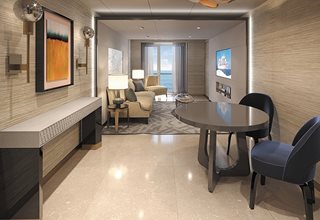
Category: SS
This suite is decorated with soothing colors, pleasing artwork, and comfortable furnishings. Relax in the sitting area after an exciting day ashore and enjoy the selection of fresh canapés delivered by your personal butler. Then retreat to your private balcony to watch the ever-changing vistas.
Suite size: 53.6 m²
Balcony size: 22 m²
Amenities:- 1-Night Pre-Cruise Hotel Package Including:
- Ground Transfers
- Breakfast
- Porterage
- Unlimited Wi-Fi Includes up to Four Logins, Four Devices, per Suite
- Valet Laundry Service
- Customizable In-Suite Mini Bar Replenished Daily with Your Preferences
- 24-hour In-Suite Dining
- Fresh Orchid Arrangement
- Luxurious Bath Amenities and Men's Unscented Shaving Kit
- Regent Plush Bathrobe and Slippers
- Interactive Flat-Screen Television and Direct-Dial Satellite Phone
- Priority Access to Online Shore Excursion Reservations
- Priority Access to Online Dining Reservations
- Binoculars
- illy® Espresso Maker
- Cashmere Blankets
- Regent Special Gift
- Vanity and Hair Dryer
- Shoe Shine Service
- Additional Discounts:
- 10% Discount on Ultra Premium Wine and Liquor
- 5% Savings on Pre- or Post-Cruise Hotel or Land Programs
- 5% Savings on Regent Choice Shore Excursions
- Personal Butler for an Elevated In-Suite Experience
- In-Suite Dining from Compass Rose
- Priority Boarding on Embarkation Day with Suite Access at 1 pm
- Daily Canapés
- Luxe Fruit Arrangement
- Luxurious Bath Amenities and Men's Unscented Shaving Kit
- Selection of Fig and Tea Leaves Bath Salts
- Bose® SoundLink Mini II Bluetooth Speaker
- Selection of Bed Pillow Styles
- Complimentary Garment Pressing on First Night
- Personalized Stationery upon request
- Elegant Weather Clock
- 1-Night Pre-Cruise Hotel Package Including:
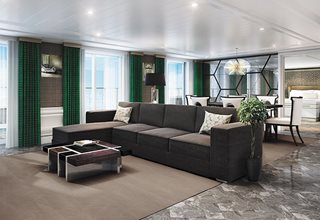
Category: GS
Step into the richness of an emerald-green dining area perfectly ensconced within a spacious, sumptuous living room. Just outside is a private balcony with a table and chairs, perfect for in-suite breakfast. The private bedroom is large and inviting, its soothing color palette perfect for a peaceful night's rest on your King-Size Elite Slumber™ Bed. Two full baths make it a perfect space for entertaining new friends on the high seas.
The suite pictured may differ from the suite booked, as layouts and designs vary by ship, deck, and suite location.
Suite size: 79.3-94.1 m²
Balcony size: 25.7-85.1 m²
Amenities:- 1-Night Pre-Cruise Hotel Package Including:
- Ground Transfers
- Breakfast
- Porterage
- Unlimited Wi-Fi Includes up to Four Logins, Four Devices, per Suite
- Valet Laundry Service
- 24-hour In-Suite Dining
- Fresh Orchid Arrangement
- L'Occitane® Jasmin & Bergamot Bath Amenities
- Regent Plush Bathrobe and Slippers
- Interactive Flat-Screen Television and Direct-Dial Satellite Phone
- Priority Access to Online Shore Excursion Reservations
- Priority Access to Online Dining Reservations
- Binoculars
- illy® Espresso Maker
- Cashmere Blankets
- Regent Special Gift
- Vanity and Hair Dryer
- Shoe Shine Service
- Additional Discounts:
- 10% Discount on Ultra Premium Wine and Liquor
- 5% Savings on Pre- or Post-Cruise Hotel or Land Programs
- 5% Savings on Regent Choice Shore Excursions
- VIP Status Including Dinner with a Senior Officer
- Guaranteed Reservation Each Night in Specialty Restaurant of Your Choice
- Welcome Letter from the President and General Manager
- Personal Butler for an Elevated In-Suite Experience
- In-Suite Dining Menu Including Specialty Restaurant Selections During Dining Hours
- Priority Boarding on Embarkation Day with Suite Access at Noon
- Welcome Bottle of Premium Champagne
- Personalized In-Suite Full-Liquor Bar Set-Up
- A Sumptuous In-Suite Caviar Service Once During Cruises
- Complimentary In-Suite Cocktail Party for 8
- Complimentary 25-Minute Personal Fitness Session at the Serene Spa & Wellness™ Fitness Center
- Delivery of up to 3 Daily Newspapers and World Atlas
- Daily Canapés
- Tea Forté Set-Up
- Luxe Fruit Arrangement with Chocolate Leonidas
- Luxurious Designer Bath Amenities & Men's Unscented Shaving Kit
- Guerlain Box with Fragrance & Spongellé Buffer
- Dyson Hair Dryer
- Selection of Fig and Tea Leaves Bath Salts
- Guerlain Bath Amenities & Men's Unscented Shaving Kit
- Bath Scale Setup
- Bose® SoundLink Mini II Bluetooth Speaker
- Selection of Bed Pillow Styles
- Complimentary Garment Pressing on First Night
- Personalized Stationery upon request
- Elegant Weather Clock
- Excursion Bag
- 1-Night Pre-Cruise Hotel Package Including:
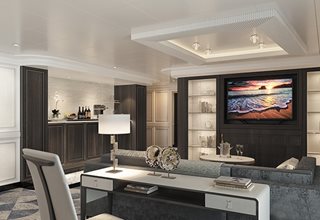
Category: SG
You'll find Park Avenue chic onboardSeven Sea Splendor® in this extravagant, stylish suite. A rich color palette, the finest fabrics and a grand piano create sophisticated comfort, while a personal butler will happily assist with both ordinary and special requests. With two spacious bedrooms, two-and-a-half baths, a large living room and a wrap-around private balcony, this suite is perfectly suited to host gatherings of new friends.
Suite size: 98.9-103.5 m²
Balcony size: 77.2-92.4 m²
Amenities:- 1-Night Pre-Cruise Hotel Package Including:
- Ground Transfers
- Breakfast
- Porterage
- Unlimited Wi-Fi and Streaming Package for up to Four Devices
- Valet Laundry Service
- 24-hour In-Suite Dining
- Fresh Orchid Arrangement
- L'Occitane® Jasmin & Bergamot Bath Amenities
- Regent Plush Bathrobe and Slippers
- Interactive Flat-Screen Television and Direct-Dial Satellite Phone
- Priority Access to Online Shore Excursion Reservations
- Priority Access to Online Dining Reservations
- Binoculars
- illy® Espresso Maker
- Cashmere Blankets
- Regent Special Gift
- Vanity and Hair Dryer
- Shoe Shine Service
- Additional Discounts:
- 10% Discount on Ultra Premium Wine and Liquor
- 5% Savings on Pre- or Post-Cruise Hotel or Land Programs
- 5% Savings on Regent Choice Shore Excursions
- VIP Status Including Dinner with a Senior Officer
- Guaranteed Reservation Each Night in Specialty Restaurant of Your Choice
- Welcome Letter from the President and General Manager
- Personal Butler for an Elevated In-Suite Experience
- In-Suite Dining Menu Including Specialty Restaurant Selections During Dining Hours
- Priority Boarding on Embarkation Day with Suite Access at Noon
- Welcome Bottle of Premium Champagne
- Personalized In-Suite Full-Liquor Bar Set-Up
- A Sumptuous In-Suite Caviar Service Once During Cruises
- Complimentary In-Suite Cocktail Party for 8
- Complimentary 25-Minute Personal Fitness Session at the Serene Spa & Wellness™ Fitness Center
- Delivery of up to 3 Daily Newspapers and World Atlas
- Daily Canapés
- Tea Forté Set-Up
- Luxe Fruit Arrangement with Chocolate Leonidas
- Luxurious Designer Bath Amenities & Men's Unscented Shaving Kit
- Guerlain Box with Fragrance & Spongellé Buffer
- Dyson Hair Dryer
- Selection of Fig and Tea Leaves Bath Salts
- Guerlain Bath Amenities & Men's Unscented Shaving Kit
- Bath Scale Setup
- Bose® SoundLink Mini II Bluetooth Speaker
- Selection of Bed Pillow Styles
- Complimentary Garment Pressing on First Night
- Personalized Stationery upon request
- Elegant Weather Clock
- Excursion Bag
- 1-Night Pre-Cruise Hotel Package Including:
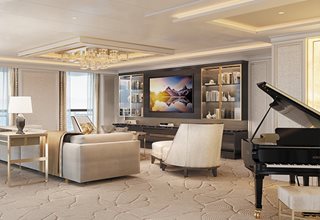
Category: RS
High atop the ship, this suite of more than 4,000 square feet (372 meters) rises above everything else at sea. Incomparable craftsmanship and meticulous attention to detail are evident in everything from the unique design choices, such as rare works of art, to grand features like an in-suite spa retreat — a first for any cruise ship. The only thing to rival the luxurious interior is the spectacular ocean view from the private balconies.
Suite size: 352.7 m²
Balcony size: 120 m²
Amenities:- 1-Night Pre-Cruise Hotel Package Including:
- Ground Transfers
- Breakfast
- Porterage
- Unlimited Wi-Fi and Streaming Package for up to Four Devices
- Valet Laundry Service
- 24-hour In-Suite Dining
- Fresh Orchid Arrangement
- L'Occitane® Jasmin & Bergamot Bath Amenities
- Regent Plush Bathrobe and Slippers
- Interactive Flat-Screen Television and Direct-Dial Satellite Phone
- Priority Access to Online Shore Excursion Reservations
- Priority Access to Online Dining Reservations
- Binoculars
- illy® Espresso Maker
- Cashmere Blankets
- Regent Special Gift
- Vanity and Hair Dryer
- Shoe Shine Service
- Additional Discounts:
- 10% Discount on Ultra Premium Wine and Liquor
- 5% Savings on Pre- or Post-Cruise Hotel or Land Programs
- 5% Savings on Regent Choice Shore Excursions
- Personal Car and Guide to Explore Ashore
- Daily Serene Spa & Wellness™ Services with Priority Reservations
- Access to The Study, a Private Dining Room for up to 12 Guests
- Unlimited Dry Cleaning
- VIP Status Including Dinner with a Senior Officer
- Guaranteed Reservation Each Night in Specialty Restaurant of Your Choice
- Welcome Letter from the President and General Manager
- Personal Butler for an Elevated In-Suite Experience
- In-Suite Dining Menu Including Specialty Restaurant Selections During Dining Hours
- Priority Boarding on Embarkation Day with Suite Access at Noon
- Welcome Bottle of Dom Pérignon Champagne
- Rémy Martin Louis XIII Cognac 50ml
- Personalized In-Suite Full-Liquor Bar Set-Up
- A Sumptuous In-Suite Caviar Service Once During Cruises
- Complimentary In-Suite Cocktail Party for 8
- Complimentary 25-Minute Personal Fitness Session at the Serene Spa & Wellness™ Fitness Center
- Delivery of up to 3 Daily Newspapers and World Atlas
- Daily Canapés
- Tea Forté Set-Up
- Luxe Fruit Arrangement with Chocolate Leonidas
- Choice of Luxurious Designer Bath Amenities
- Spa Accessories and Spongology Collection
- Guerlain Box with Fragrance & Spongellé Buffer
- Dyson Hair Dryer
- Selection of Fig and Tea Leaves Bath Salts
- Guerlain Bath Amenities & Men's Unscented Shaving Kit
- Bath Scale Setup
- Wallet Make Up Brush Set / Hairbrush and Combo Set
- Bose® SoundLink Mini II Bluetooth Speaker
- Selection of Bed Pillow Styles
- Linen Menu
- Complimentary Garment Pressing on First Night
- Personalized Stationery upon request
- Elegant Weather Clock
- Excursion Bag
- 1-Night Pre-Cruise Hotel Package Including:
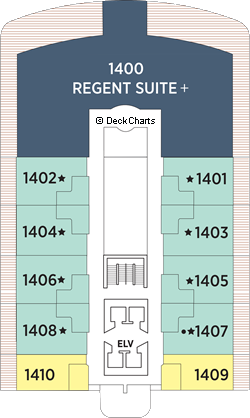
| Symbol | Description |
|---|---|
 | 2-bedroom suites accommodate up to six guests |
 | Convertible sofa bed |
 | Wheelchair accessible suites 822, 823, and 916 have a shower instead of bathtub |
 | Connecting suites |
 | Bathroom features a glass-enclosed shower instead of a bath in categories A, B, C, G1, G2, and H |
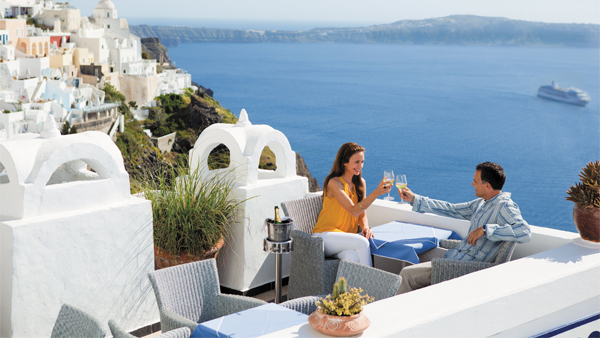
- Ship Name: Seven Seas Splendor
- Year Built: 2020
- Year Entered Present Fleet: 2020
- Ship Class: Oceanliner
- Maximum Capacity: 750
- Number of Passenger Decks: 10
- Number of Crew: 542
- Officers' Nationality: European
- Tonnage (GRT): 55,254
- Capacity Based on Double Occupancy: 750
- Country of Registry: Marshall Islands
- Total Staterooms: 377
- Suites with Balcony: 375
- Crew/Hotel Staff Nationality: European/International
Costco Member Reviews

Available Dates & Prices
Terms & Conditions
*Price shown is per person based on double occupancy, is valid for select stateroom categories only and does include government taxes/fees and gratuities. Click on the Terms & Conditions link below for details.
**Select complimentary shore excursions are for full-fare guests only, capacity controlled and subject to availability. Shore excursion reservations are accepted on a first-come, first-served basis. Please note, available excursions vary by sailing date and day of the week. Government fees and taxes are included. Requested excursions may not be available at time of booking. Supplement will apply on Regent Choice excursions and excludes Private Arrangements and all Adventures Ashore programs. Restrictions apply and penalties apply 36 hours prior to shore excursion start date.
††All shipboard credit is in U.S. dollars, is per stateroom based on double occupancy, has no cash value, is nontransferable and not redeemable for cash.
†One Digital Costco Shop Card per room/stateroom, per stay. The exact amount of the Digital Costco Shop Card will be calculated during the booking process. The Digital Costco Shop Card promotion is nontransferable and may not be combined with any other promotion. A Digital Costco Shop Card will arrive by email approximately 10 days after the start of your cruise. Click on the Terms & Conditions link below for additional information.
Ship's registry: The Marshall Islands
Digital Costco Shop Card
Book this vacation or cruise with Costco Travel and receive a Digital Costco Shop Card. The Digital Costco Shop Card is a convenient payment option in our warehouses and on Costco.com.
















